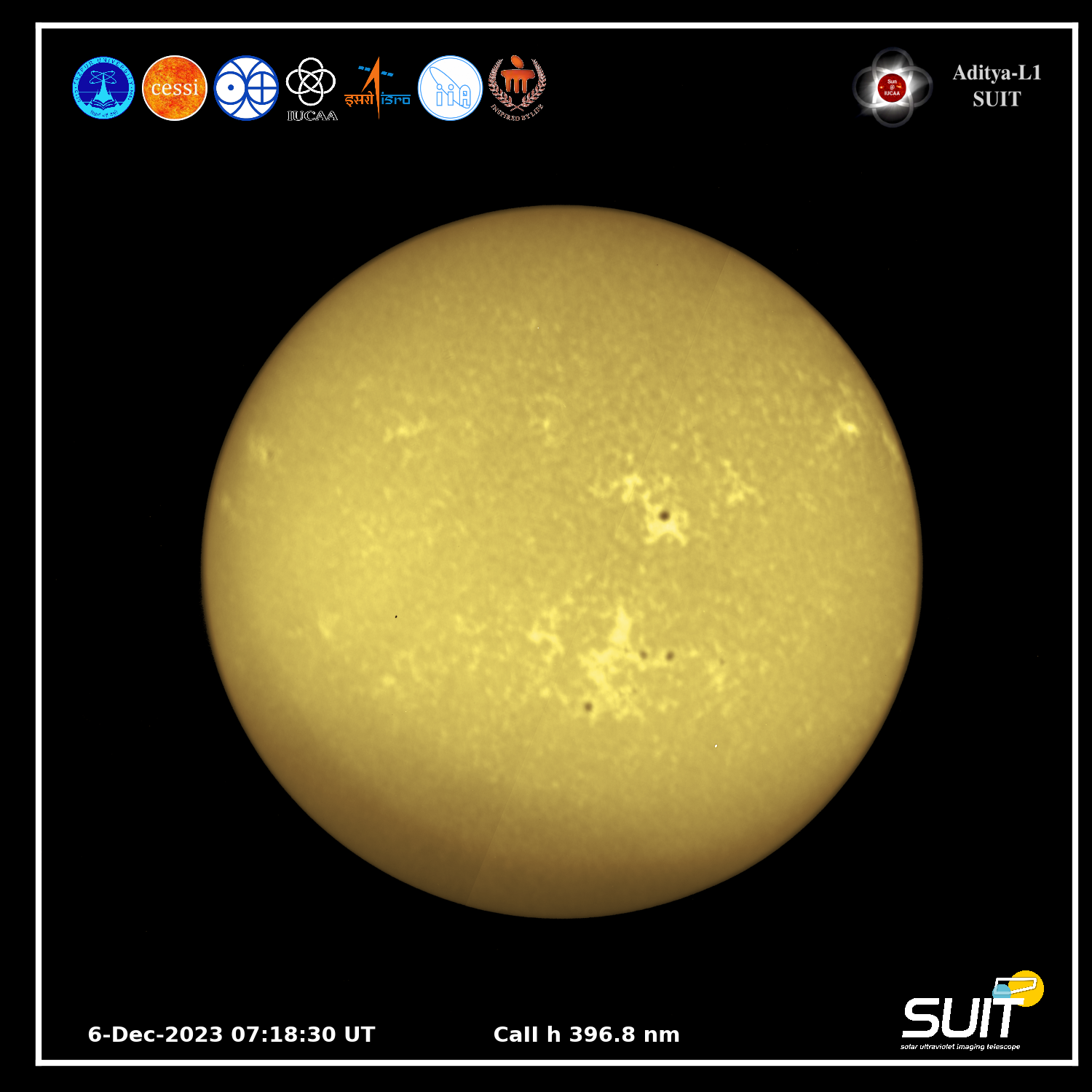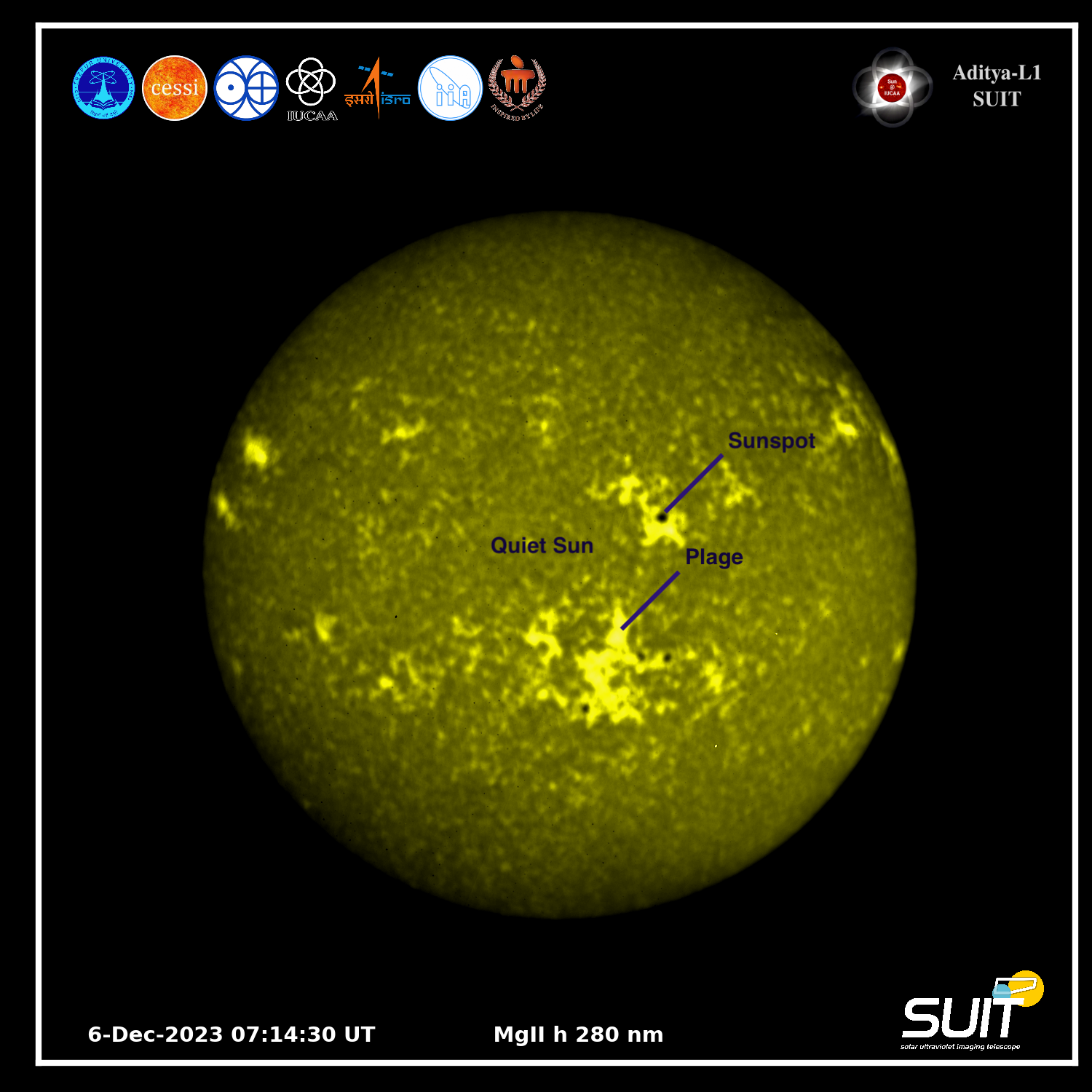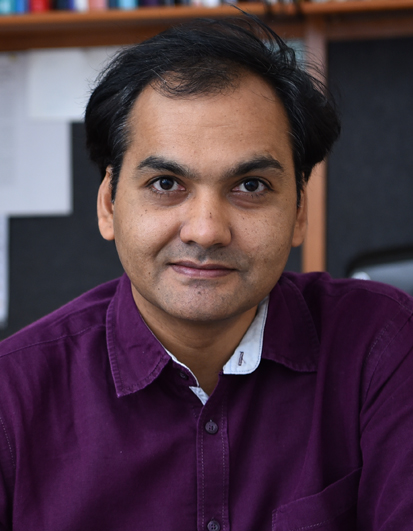
Image credit: ISRO/IUCAA
In a monumental achievement for the Indian solar science community, the Solar Ultraviolet Imaging Telescope (SUIT) on board the Aditya-L1 spacecraft has successfully captured its first light images, marking a crucial milestone in the mission. The instrument payload, which was designed at the Inter-University Centre for Astronomy and Astrophysics (IUCAA) in Pune, will pave a path in our understanding of the Sun's dynamics and yet inexplicable phenomenon close to its surface.
SUIT, equipped with 11 specialized light filters operating in the 200-400 nm (Ultraviolet) wavelength range, is designed to continuously provide high-resolution images of the Sun's photosphere and chromosphere. The recent observations, first ones using three different filters—Mg II h (280.3 nm), Mg II k (279.6 nm), and Narrow Band 6 (300 nm)—have revealed the first details about the Sun's surface and atmospheric layers like the chromosphere and photosphere. Subsequently all filters have now been successfully tested and are giving good images.
SUIT Unveils Sun's Hidden Layers:

Image credit: ISRO/IUCAA
Prof. Durgesh Tripathi, Principal Investigator of SUIT says: “It is a lifetime opportunity for a scientist to conceive the idea of such a complex space telescope payload and then to get to see the first light observations. Full disk images in this combination of wavelengths are being taken for the first time ever by a space telescope. They show the intricate details of features in the lower and middle solar atmosphere. The data taken by SUIT will open a new window for solar atmospheric studies and will help us understand the solar activity in greater detail. Moreover, set clear limits on the sunlight's energy output at these wavelengths, that is central to the sun-climate relationship.” These observations will put India at the forefront of solar studies from space internationally and provide ample data for researchers at different universities and institutions within the country to perform frontline research in the field.
As the scientific community eagerly awaits the Aditya-L1 spacecraft reaching the destination orbit around the 1st Lagrangian point of the Earth-Sun system, preparations and training are also being conducted to make future scholars ready for further data acquisition and analysis.
Prof. A. N. Ramaprakash, the payload manager and instrument Principal Investigator of SUIT says: “The SUIT instrument has been conceived to bring several novel observational capabilities to the Solar physics community. It will help astronomers to study several long standing questions about the Sun as well its influence on Earth. Early stage data indicate that the instrument's components are performing as per expectations. The entire SUIT team, spread across multiple institutions, is thrilled at achieving this major milestone. It has been a gratifying journey.”
Prof. Nishant Singh, another solar physicist at IUCAA says: “SUIT will help us better understand various physical processes behind the energetic events that take place in the solar atmosphere. One of the biggest puzzles of solar physics is the solar coronal heating problem, and due to its capability of probing different layers of chromosphere, SUIT will provide important clues on the energy transfer mechanisms which lead to the formation of a corona with temperatures exceeding million degree Kelvin. Moreover, studying the properties of seismic modes in the solar atmosphere using SUIT data may help us predict eruptive events, such as flares and CMEs, which impact the space weather.”
Prof. R. Srianand, the Director of IUCAA said “I am excited to see the first set of images taken with SUIT. They look great and we are looking forward to seeing well calibrated images that will unravel physics in the outer regions of the Sun. I congratulate the team and wish them all the best in their ongoing efforts to fully commission this instrument!”
SUIT's development was spearheaded by Prof. A. N. Ramaprakash and Prof. Durgesh Tripathi at IUCAA, Pune, in collaboration with ISRO, the Manipal Academy of Higher Education (MAHE), Centre for Excellence in Space Science Indian (CESSI) at IISER-Kolkata, the Indian Institute of Astrophysics Bengaluru, Udaipur Solar Observatory (USO-PRL), and Tezpur University Assam.
Paving the Way for Solar Science
The successful activation and imaging by the SUIT payload promises to provide a significantly better ability to study the Sun's behavior particularly of the regions that emit energetic Ultraviolet radiation. When fully operational, SUIT will allow scientists to explore the dynamic coupling of the magnetized solar atmosphere.As the scientific community eagerly awaits the Aditya-L1 spacecraft reaching the destination orbit around the 1st Lagrangian point of the Earth-Sun system, preparations and training are also being conducted to make future scholars ready for further data acquisition and analysis.
Prof. A. N. Ramaprakash, the payload manager and instrument Principal Investigator of SUIT says: “The SUIT instrument has been conceived to bring several novel observational capabilities to the Solar physics community. It will help astronomers to study several long standing questions about the Sun as well its influence on Earth. Early stage data indicate that the instrument's components are performing as per expectations. The entire SUIT team, spread across multiple institutions, is thrilled at achieving this major milestone. It has been a gratifying journey.”
Prof. Nishant Singh, another solar physicist at IUCAA says: “SUIT will help us better understand various physical processes behind the energetic events that take place in the solar atmosphere. One of the biggest puzzles of solar physics is the solar coronal heating problem, and due to its capability of probing different layers of chromosphere, SUIT will provide important clues on the energy transfer mechanisms which lead to the formation of a corona with temperatures exceeding million degree Kelvin. Moreover, studying the properties of seismic modes in the solar atmosphere using SUIT data may help us predict eruptive events, such as flares and CMEs, which impact the space weather.”
Prof. R. Srianand, the Director of IUCAA said “I am excited to see the first set of images taken with SUIT. They look great and we are looking forward to seeing well calibrated images that will unravel physics in the outer regions of the Sun. I congratulate the team and wish them all the best in their ongoing efforts to fully commission this instrument!”
Historic Activation on November 20, 2023
The SUIT payload, a culmination of a decade-long development effort by the team at IUCAA, was officially switched on November 20, 2023. Following successful pre-commissioning procedures, the first light images were captured on December 6, 2023, marking a significant achievement for the teams involved in the project.A Decade of Dedication: SUIT's Journey to Space
The conceptualization of the SUIT payload dates back to 2013, and after meticulous development, it was delivered to the Indian Space Research Organization (ISRO) on June 06, 2023. The final integration with the Aditya-L1 spacecraft was completed, leading to the historic launch on September 02, 2023.SUIT's development was spearheaded by Prof. A. N. Ramaprakash and Prof. Durgesh Tripathi at IUCAA, Pune, in collaboration with ISRO, the Manipal Academy of Higher Education (MAHE), Centre for Excellence in Space Science Indian (CESSI) at IISER-Kolkata, the Indian Institute of Astrophysics Bengaluru, Udaipur Solar Observatory (USO-PRL), and Tezpur University Assam.
About Aditya-L1:
Aditya-L1 is India's pioneering solar observation mission, aimed at studying the Sun's outermost layer—the corona, its other violent and less understood regions and its impact on the Earth's climate. Developed by the Indian Space Research Organization (ISRO), the mission is equipped with cutting-edge instruments, including the Solar Ultraviolet Imaging Telescope (SUIT), contributing valuable data to the global understanding of solar dynamics. The mission also stands as a testament to the collaborative efforts of multiple Indian institutions, showcasing India's prowess in space exploration and solar science.About IUCAA:
The Inter-University Centre for Astronomy and Astrophysics (IUCAA), located in Pune, is a leading institution dedicated to research and development in astronomy and astrophysics. It fosters collaboration between universities and institutes across India and promotes excellence in scientific inquiry and discovery. IUCAA is affiliated to the University Grants Commission (UGC).
Find the Hindi translation of the above text here: Click Here
Research contacts:
 |
Prof. Durgesh Tripathi IUCAA, Pune E-mail: durgesh_at_iucaa.in |
 |
Prof. A. N. Ramaprakash IUCAA, Pune E-mail: anr_at_iucaa.in |
